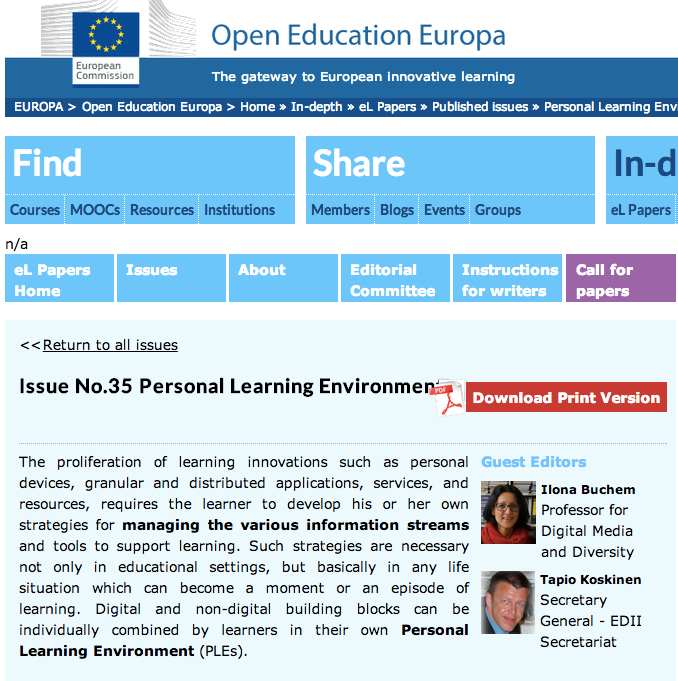This winter semester I am starting a new professorship called “Digital Media & Diversity”, which anchored at the Gender and Technology Center at Beuth University of Applied Sciences. As my research and teaching will focus a range of topic related to diversity and new forms of digital media (including web 2.0, social media, mobile web, digital games), I have been looking at digital media use, concepts and initiatives from the diversity perspective (see for example my presentation from the ePortfolio and Identity Conference 2012 in London titled “Gender and ePortfolio Practice”).
One of the most recent works is the position paper titled “Diversity and Divide in TEL: The Case for Personal Learning Environments”, which Graham Attwell and me submitted for the workshop on TEL, The Crisis and the Response for the Alpine Rendez-Vous 2013.
Below is the text of this position paper, which Graham already posted here. What do you think? Can you relate to the idea of diversity and divide in TEL?
Looking forward to your comments!
“The digital divide cannot be discussed only as a gap between technology haves and have-nots. Below the inequalities in access and usage, there is also a problem of a divide between contexts, domains and communities that different learners operate in. The need for empowered learners as citizens engaging in cross-boundary, problem-solving has been advocated as a necessary means for social innovation. It is through boundary-crossing or bridging the divides that individual and sociocultural differences can become a resource. However, mainstream TEL has not fully recognised the potential of boundary crossing and engaging diverse learners in collective action related to solving real life problems. Much of TEL is developed to fit the prevailing educational paradigm, focusing on ever more efficient management of learning and more reliable methods of assessment rather than encouraging learners to explore diverse ideas, experiment with diverse formats or build bridges to diverse communities.
Can promoting diversity through TEL be a response to crisis? Certainly, in view of the growing complexity of societal, environmental and economic challenges and the ever increasing amount of information and communication possibilities, diversity may raise new questions, challenges and concerns. However, both research and practice provide evidence that diversity, in terms of individual or group attributes as well as in terms of different content, resources and tools provides valuable opportunities for intellectual engagement, personal growth and the development of novel solutions.
In this position paper, we discuss whether current TEL promotes diversity or divide and the current barriers in promoting diversity in TEL. We discuss these issues based on the example of Personal Learning Environments (PLE), which is as an approach to TEL aiming at empowering learners to use diverse technological tools suited to their own needs and connecting with other learners through building Personal Learning Networks. We argue that this approach to TEL promotes diversity through boundary-crossing and responding to the diverse needs and prerequisites that each individual learner brings in. At the same time we discuss how the PLE approach challenges current educational practices and what tensions arise when Personal Learning Environments are implemented in educational institutions.
Personal Learning Environments, as an approach to TEL, focus on the learner-controlled and learner-led uses of technologies for learning with no centralised control over tools, information or interactions. This strong focus on autonomous, literate learners as agents and decision-makers taking control and claiming ownership of their learning environments is of course in contrast with regulated and planned processes at schools and universities, demanding radical changes in the prevailing educational paradigm. TEL, based on the Personal Learning Environments approach, vests learners with control over learning processes and outcomes, including planing, content, interactions, resources and assessment. In this way, the PLE approach challenges not only the prevailing educational paradigm, but also TEL approaches inspired by this paradigm, such as Learning Management Systems and pre-programmed, locked-down systems, such as some types of video games or mobile apps, which place learners in the role of recipients and consumers of systems devised by others, while failing to foster both generativity and boundary-crossing.
Such pre-programmed, quality-controlled and locked-down approaches to TEL have led to “walled gardens in cyberspace”, isolating different learners and learning contexts, posing external constraints on what learners can do in such environments in terms of activities, resources and tools. Alternatively, learner-controlled uses of technologies, as embodied in the Personal Learning Environments approach, have facilitated boundary crossing and merging multiple learning contexts, domains and communities.
The postulate of boundary-crossing through the PLE approach has a human and technological dimension. On one hand, the PLE approach calls for learners to claim and make use of ownership and control over their learning environment, exerting agency in terms of the human capacity to make choices and uses those choices in real world interactions. On the other hand, the PLE approach calls for openness, decentralisation, connectivity and permeability of technological systems.
With learner ownership, control and agency combined with openness, decentralisation, connectivity and permeability of technological systems being the core attributes of the PLE approach to TEL, diversity becomes natural. The PLE approach promotes diversity of social interactions, diversity of learning contexts and diversity of learning practices. Personal Learning Environments entail diverse people and communities coming together, diverse technology tools and platforms used and combined by learners, diverse content production and consumption modes, diverse access points and modes of learning.
However, diversity promoted by the PLE approach is a source of conflict when PLEs and other systems interact. Specifically, tensions arise at the points traditionally considered as legitimate divides in the education system including TEL, for example (a) private vs. public access, (b) course members vs. non-members, (c) disciplinary knowledge vs. practice-based knowledge, (d) formal vs. informal learning context, (e) expert vs. novice, (f) individual vs. collective practice, (g) assessment vs. reflection, (h) planning vs. implementation, or (i) standards vs. innovation.
We argue that challenging these presumably legitimate boundaries in TEL as postulated by the PLE approach is a way to innovation which may bring viable responses to the crises.”






